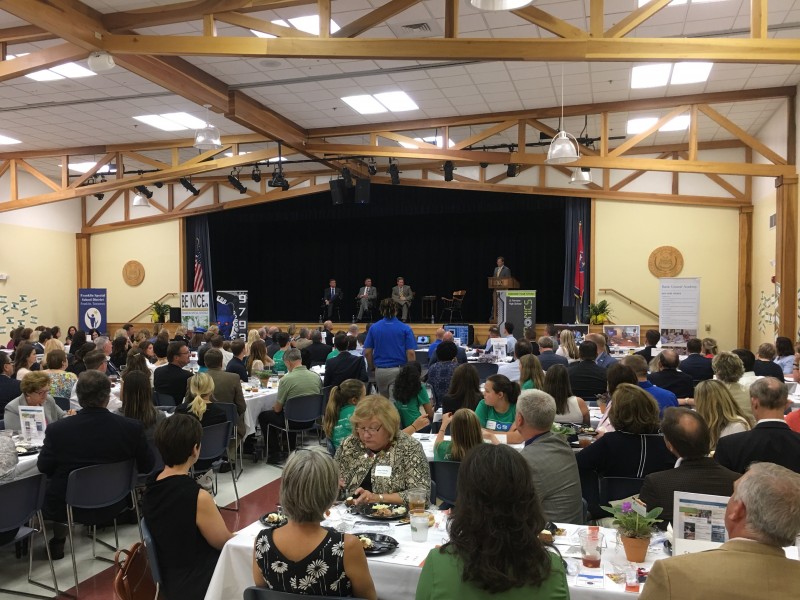Together, Williamson County public and private schools create one of the best schools systems in the state and country.
Business, government and parent leaders all seem to agree that the county’s schools are its the crown jewel and perhaps the most important contributor to continued success.
So, over all, a very positive picture emerged Tuesday from 11 a.m. to 1 p.m. at Battle Ground Academy, when a panel consisting of Williamson County Schools Superintendent Dr. Mike Looney, Franklin Special School District Director of Schools Dr. David Snowden and BGA Head of Schools Will Kesler spoke about the “State of Our Schools.” But the pace of change create a need for constant adaptation to stay on top.
Adapting to a Changing World
The number of students in the county is projected to increase by several thousand each year for the next decade. Meanwhile, on a large scale, technology is advancing at a constant pace, which had a huge impact on how things work in the classroom and also the career paths that the classrooms are preparing students for.
“We operate in a time when change is happening constantly,” Looney said, “And a big challenge is dealing with the change process and the chaos around change,”
Williamson, Inc, CEO Matt Largen, who mediated the panel, set the tone with an introductory speech focusing on the increased role of, and focus on, technology and IT teaching in schools.
In 2017 Williamson County companies filled 2200 IT jobs, he said. However, there were still more than 1500 positions in IT here that needed to be filled.
“That is really not unique to here; it is seen across the country,” he said.
There is a great need for an increase in students going into the IT field, he said.
In response to that a few years ago, WCS started an extracurricular coding program in middle school.
The intent was that the early exposure to information-technology would translate into students pursuing technology career paths in high school and college.
The program began in just a few middle schools, but this year will expand to almost every middle school. Already 300 students have entered the activity, leading to a direct increase in student pursuing an IT path. In the next five years, Largen said, that number will increase 300 percent. He said this response to the real world is unique to the county.

IT in the Classroom
Technology is not just a career path, but it has changed the way school and learning works.
Kesler said that at BGA there is a 1 to 1 ratio of students to IT devices used in learning and the classrooms.
“The effects have not just been that students are not lugging around 50 pound backpacks, it has changed how they learn,” he said.
For instance, by having a tablet instead of textbook students can immediately look up words, cross reference concepts to other subjects and take digital notes right in the text.
However, the flip side is the distractions that devices create, with access to apps, the internet, etc….
“We can build the walls around the pool higher and higher, but at some point it might be better just to teach students to swim,” he said.
Looney talked about devices in the classroom and how they widen students ability to learn and intake information.
If a student is a visual learner he said they can take a picture of the algorithm on the board. If they are an auditory learner they can record the lesson and so on. He said that WCS had a ratio of about 2.5 students per device, and that he wasn’t sure if they would get to 1 to 1. But students he said largely already have smart phones, and WCS is trying to teach them to– and let them– take advantage of that.
“There is the 8 a.m. to 3 p.m. world of school and the 3:01 p.m. to 7:59 a.m. world,” Looney said. “We think they should be one.”
Looney also emphasized the importance of the classroom teaching practical skills, not just preparing students for college but for life and work. He used as an example troubleshooting a not working wifi signal in a class, and letting students figure out how to troubleshoot and solve the problem on their own, rather than a teacher taking time out of the lesson to help, while teaching the students self-sufficiency and independent thinking.

The Best Around
Overall, the schools in the county remain among the best in the state and country even while facing constant change.
The percentage of students graduating from high school is substantially higher than in the state and the country; while the rate of students who get Bachelor and Masters’s degrees is double state and national numbers.
The county’s high school graduation rate of 95 percent compares to 86 percent nationally and 85 percent in Tennessee.
The percentage graduating from a four-year college is 56 percent, against 29 percent nationally and 25 percent statewide.
And the percentage of students who gain a graduate degree is 20 percent here to 11 percent nationally and 9 percent in Tennessee.
Please join our FREE Newsletter




